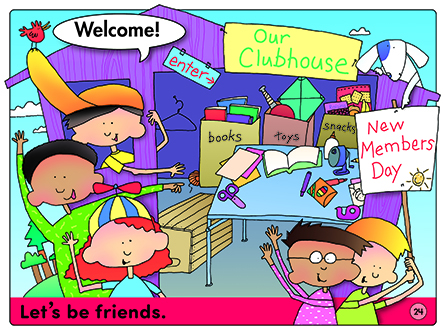Additional Activities
These activities offer options for continuing the learning in this unit. Whether your curriculum is skill-based or more open-ended, select the activities that are most appropriate for the children in your classroom. The Writing Spot is primarily a writing program, but writing can be integrated throughout your curriculum—in art, drama, reading, math, and science.
-
Create friendship posters.
Talk about how friends help each other to learn new skills; to feel better when they are sick, afraid, or lonely; and so on. Have children draw a picture of friends helping each other. Use "A Friendship Poster" for this activity.
-
Explore various types of friendships.
Since many children have friendly relationships with family members, neighbors, baby-sitters, and others, take time to talk about these different kinds of friends. You might read books about intergenerational friendships, including Wilfrid Gordon McDonald Partridge by Mem Fox, and Patricia Polacco’s books The Bee Tree and Mrs. Katz and Tush.
Have children cut sheets of paper in half and staple them together. Each child writes his or her name on the cover and decorates the booklet. Then give the children time to get one another’s autographs.
-
Write the rules for games.
Ask children to name games they like to play with friends. With the help of the children, list the names of the games on the board or chart paper. Have children explain the rules of these games. Write some of them down. Encourage children to play these games together.
-
Explore how people are alike and different.
Talk with children about how they are alike in some ways and different in others. All of them are in kindergarten, but they differ in their physical appearance, interests, number of brothers and sisters, and so on. Encourage conversations that allow children to talk about how they are alike and different. Encourage kindness!
-
Make friends of all ages, shapes, and sizes.
Discuss how we choose our friends. Talk about shared interests, personalities, and lifestyles. Talk about adult friends like teachers, older family members, police officers, and doctors. Encourage children to look beyond physical appearance when choosing friends. Does anyone have a friend with a disability? Ask children to share stories about their friends.
-
Discuss the qualities of friends.
What is a friend? List children’s answers and ask more questions: Are friends polite? Do friends share? Do friends work and play together? Create a class book titled “What is a friend?”
-
Welcome new friends to the class.
Early in the school year, talk with your class about the possibility of new children joining the class throughout the year. Explain that sometimes families move in the middle of the school year, and children must go to new schools. Talk about ways to welcome new children to class. Write a class welcome song and ask for volunteers to act as a welcoming committee to show new children around and introduce them to new friends. Reinforce this idea often so that children will be ready to act if a new child arrives.
-
Make name tags and find new friends.
Talk about where students can find new friends: in their neighborhoods, at school, at church, at a team activity. Have children draw, tell, or write about making a new friend. Discuss what they may want to ask a new friend: What’s your name? Where do you live? Do you have a pet? Then let each child make a name tag (self-sticking). Assign partners to put on their name tags and ask one another some of the “new friend” questions. Encourage students to ask additional questions as they think of them. After a time, ask children to switch partners and ask more questions. Some new friendships may emerge within your class.
-
Write about having fun with friends.
Discuss with the children how the whole class has fun together. Then encourage the children to share ways in which they have fun with their friends. Invite them to write stories about the fun things they do with their friends.
